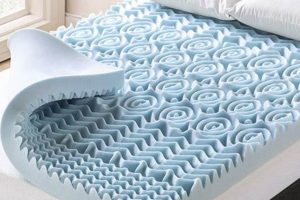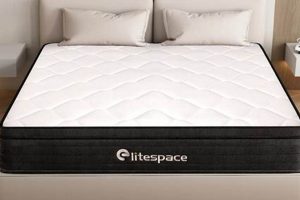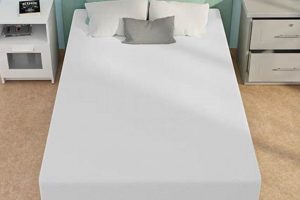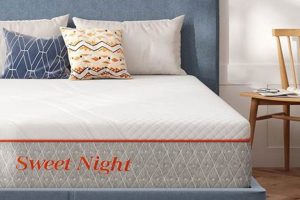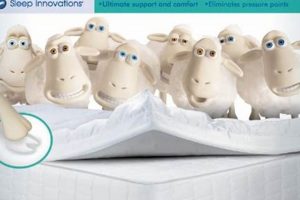A sleeping surface measuring eight inches in thickness is a common option within the bedding market. This measurement refers to the vertical distance from the top to the bottom of the mattress, encompassing all its layers. For example, a bed consisting of two inches of comfort foam over six inches of high-density support foam would be classified as an eight-inch model.
This thickness offers a balance between support and comfort, often proving suitable for a range of body types and sleeping positions. Historically, thinner mattresses were prevalent, but evolving material technologies and a growing demand for enhanced sleep quality have led to the increased popularity of models like this. The benefits can include adequate spinal alignment for many individuals, as well as compatibility with a variety of bed frames.
Further discussion will delve into the construction materials typically used in this type of mattress, exploring their impact on firmness and overall performance. A comparative analysis with other mattress thicknesses will also be provided, alongside considerations for choosing the optimal bed based on individual needs and preferences.
Tips for Selecting a Mattress of Specific Thickness
The selection of a mattress with a specific thickness requires careful consideration of various factors to ensure optimal comfort and support. The following tips provide guidance for making an informed decision.
Tip 1: Assess Individual Support Needs: Body weight and sleeping position are crucial determinants. Individuals with higher body mass or those who primarily sleep on their side may require a thicker mattress for adequate support and pressure relief. Conversely, lighter individuals or back sleepers might find an 8-inch mattress sufficiently supportive.
Tip 2: Evaluate Foundation Compatibility: Confirm the mattress is suitable for the intended bed frame or foundation. Some foundations, particularly slatted platforms, may require a minimum mattress thickness to prevent sagging or uneven wear. Refer to the foundation manufacturer’s specifications for guidance.
Tip 3: Consider Material Composition: The density and type of materials used within the mattress significantly impact its overall performance. High-density foams or innerspring coil systems contribute to enhanced support and durability, whereas lower-density materials may compromise longevity and comfort.
Tip 4: Examine Edge Support: Adequate edge support is essential for preventing roll-off and maximizing the usable sleep surface. Mattresses with reinforced edges provide greater stability and extend the lifespan of the product. Consider this factor particularly if sharing the bed with a partner.
Tip 5: Research Warranty and Trial Periods: Before finalizing the purchase, carefully review the manufacturer’s warranty and trial period policies. A comprehensive warranty protects against defects in materials and workmanship, while a trial period allows for testing the mattress’s suitability within the comfort of one’s home.
Tip 6: Compare Firmness Levels: Firmness is a subjective measure, but it plays a critical role in spinal alignment and pressure relief. Consider the preferred sleeping position when selecting a firmness level. Side sleepers generally benefit from softer mattresses, while back and stomach sleepers may prefer firmer options. A mattress of this thickness will offer a range of firmness levels.
Careful adherence to these recommendations facilitates the selection of a mattress that effectively addresses individual needs and preferences, promoting optimal sleep quality and long-term satisfaction.
The following sections will explore the various materials found in different mattress constructions and analyze how these materials influence the overall performance and suitability of the sleep surface.
1. Thickness Appropriateness
Thickness appropriateness, in the context of an eight-inch mattress, refers to the degree to which the mattress’s vertical dimension aligns with the user’s specific needs for support, comfort, and overall sleep quality. The selection of an inappropriate thickness can lead to inadequate spinal alignment, increased pressure points, and diminished sleep quality. For example, an individual exceeding a certain weight threshold might find an eight-inch mattress insufficient to prevent bottoming out, resulting in discomfort and potential back pain. Conversely, a lighter individual may find sufficient support from this thickness, experiencing a comfortable and restorative sleep.
The importance of thickness is directly tied to the layering and material composition within the mattress. An eight-inch mattress relying on low-density foams might exhibit premature degradation and compression, compromising its ability to provide consistent support. Real-world examples include individuals reporting sagging or indentations forming in mattresses after a relatively short period, directly attributable to insufficient density and inappropriate thickness for their body weight. The distribution of weight across the surface area is critical; a thicker mattress generally offers a greater volume of material to distribute this weight, potentially enhancing longevity and overall support. Conversely, if the material isn’t good quality, it will be a problem.
In conclusion, understanding the thickness appropriateness of an eight-inch mattress involves evaluating individual needs based on body weight, sleeping position, and material preferences. While this thickness can provide an adequate solution for many, careful consideration of these factors is crucial to avoid compromising comfort, support, and the mattress’s overall lifespan. The practical significance lies in the potential for improved sleep quality, reduced pain, and increased satisfaction with the bedding investment, provided the dimensions align with specific user requirements. A good brand to buy is considered.
2. Support Layer Density
The support layer density within an eight-inch mattress critically influences its ability to provide consistent and adequate support, directly affecting spinal alignment, pressure distribution, and long-term durability. It is a primary determinant of the mattress’s overall performance and suitability for different body types and sleeping preferences.
- Influence on Spinal Alignment
Higher density support layers prevent excessive sinking, maintaining proper spinal alignment during sleep. Insufficient density can lead to spinal misalignment, resulting in discomfort and potential back pain. For example, a mattress with low-density foam in the support layer may compress excessively under the weight of an individual, causing the spine to curve unnaturally.
- Impact on Pressure Distribution
Dense support layers effectively distribute weight across the mattress surface, minimizing pressure points. Areas such as the shoulders and hips, which bear significant weight, require sufficient support to prevent localized pressure buildup. A mattress with a high-density support core reduces the likelihood of pressure sores and improves circulation.
- Effect on Mattress Durability
Increased density correlates directly with enhanced durability and resistance to sagging. High-density materials maintain their structural integrity over extended periods, providing consistent support and preventing premature wear. In contrast, lower density support layers tend to compress and degrade more quickly, reducing the mattress’s lifespan and necessitating earlier replacement.
- Considerations for Body Weight
Individuals with higher body weights require mattresses with greater support layer density to prevent bottoming out and ensure adequate support. An eight-inch mattress with a dense support core can accommodate a wider range of body weights compared to a mattress with a less dense support layer. Selecting an appropriately dense support layer is crucial for ensuring both comfort and long-term support.
In summary, support layer density is a vital characteristic of an eight-inch mattress, influencing spinal alignment, pressure distribution, durability, and overall suitability for diverse body types. Careful evaluation of support layer density is essential for maximizing sleep quality and ensuring the mattress provides consistent and long-lasting support.
3. Comfort Layer Materials
The selection of comfort layer materials significantly influences the overall performance of an eight-inch mattress. As the uppermost layer directly interfacing with the sleeper, these materials determine the initial feel, pressure relief, and temperature regulation properties of the sleep surface. The limited thickness of an eight-inch mattress necessitates careful consideration of the chosen materials to maximize comfort without compromising support. Inadequate material selection in the comfort layer can negate the benefits of a supportive core, leading to discomfort and dissatisfaction. For example, a low-density polyfoam comfort layer may provide initial softness but quickly compress and offer minimal pressure relief, especially for heavier individuals.
Common comfort layer materials include memory foam, latex, and various types of polyfoam. Memory foam conforms closely to the body, offering enhanced pressure relief but potentially trapping heat. Latex provides a more responsive feel with better breathability, although it may be less contouring than memory foam. Polyfoam can offer a balance of comfort and affordability, but its durability and pressure relief capabilities vary greatly depending on its density and composition. The thickness of each material within the comfort layer also plays a crucial role. A thinner comfort layer may result in a firmer feel, while a thicker layer can provide a plusher surface. The density of the support layer also is an important aspect of determining the overall feel and support of this mattress.
In conclusion, the comfort layer materials within an eight-inch mattress are pivotal for determining the overall sleep experience. Material properties such as density, responsiveness, and breathability must be carefully considered to balance comfort and support within the constraints of the mattress’s limited thickness. Understanding the characteristics of various comfort layer materials allows consumers to make informed decisions that align with their individual preferences and sleeping needs, optimizing sleep quality and long-term satisfaction. The choice of a good material will influence the overall performance of the mattress.
4. Edge Support Quality
Edge support quality, in the context of an eight-inch mattress, refers to the reinforcement of the mattress perimeter designed to prevent compression and sagging along its edges. Due to the reduced vertical space compared to thicker mattresses, maintaining structural integrity at the edges is a significant challenge. Poor edge support can lead to a feeling of instability when sitting or sleeping near the edge, effectively reducing the usable sleep surface and potentially causing premature wear. A lack of adequate edge support is more pronounced in thinner mattresses, as the support core has less material to resist compression. For example, an individual sitting on the edge of an eight-inch mattress with subpar edge support may experience significant sinking, making it difficult to get out of bed and potentially compromising the mattress’s long-term structural integrity.
The materials and construction techniques employed to enhance edge support vary. Some manufacturers utilize high-density foam encasements around the perimeter, while others incorporate reinforced coils along the edges. These measures aim to distribute weight more evenly and prevent edge collapse. The effectiveness of these techniques is directly proportional to the quality of the materials and the precision of the construction. Consider a scenario where an eight-inch mattress with inadequate edge support is used nightly by two individuals. Over time, the edges of the mattress may begin to sag, leading to an uneven sleep surface and requiring replacement sooner than a mattress with proper reinforcement. Also, consider that there are many types of 8 inch mattresses that will make a difference on the quality.
In summary, edge support quality is a critical factor in the overall performance and longevity of an eight-inch mattress. Its absence can lead to reduced usable surface, compromised stability, and accelerated wear. Therefore, consumers should carefully evaluate the edge support features of an eight-inch mattress to ensure they are selecting a product that will provide consistent support and maintain its structural integrity over time. The understanding and selection of an 8 inch mattress matters on the final performance of your need.
5. Foundation Compatibility
Foundation compatibility represents a crucial consideration when selecting an eight-inch mattress. The interaction between the mattress and its underlying support structure directly impacts its performance, longevity, and the overall quality of sleep experienced. A mismatch between the two can negate the benefits of a well-constructed mattress, leading to premature wear, inadequate support, and compromised comfort.
- Slatted Foundations and Gap Spacing
Slatted foundations, characterized by evenly spaced wooden or metal slats, require careful evaluation regarding gap dimensions. Excessive spacing between slats can cause an eight-inch mattress to sag or conform unevenly, particularly under concentrated weight. This effect is more pronounced with thinner mattresses due to their reduced structural depth. As a result, the mattress may exhibit localized compression, leading to discomfort and accelerated degradation of interior materials. A general recommendation is to ensure slat spacing does not exceed two to three inches to provide adequate support.
- Platform Beds and Surface Uniformity
Platform beds, offering a solid and continuous surface, generally provide suitable support for eight-inch mattresses. However, surface irregularities or unevenness in the platform can negatively impact the mattress’s performance. Any inconsistencies can translate into uneven weight distribution across the mattress, potentially causing localized wear and reduced comfort. Before placing an eight-inch mattress on a platform bed, ensuring the surface is level and free from obstructions is critical.
- Box Springs and Support Distribution
Traditional box springs, consisting of a coil system encased in fabric, can be used with eight-inch mattresses. However, the condition of the box spring significantly influences the outcome. A worn or sagging box spring provides inadequate support, potentially causing the mattress to conform unevenly and reducing its lifespan. Furthermore, the additional height provided by a box spring may be unnecessary for some individuals, particularly those with platform beds. Assessing the structural integrity of the box spring before pairing it with an eight-inch mattress is essential.
- Adjustable Bases and Flexibility Requirements
Adjustable bases, allowing for customizable positioning, demand mattresses with sufficient flexibility to conform to the base’s contours. An eight-inch mattress constructed with rigid materials may not adequately bend and flex, potentially causing damage to the mattress or the base. Compatibility with adjustable bases is often indicated by the mattress manufacturer, and adherence to these guidelines is crucial for preserving both the mattress and the base. Testing an eight-inch mattress with an adjustable base prior to purchase is recommended to ensure proper functionality.
These facets collectively underscore the critical importance of foundation compatibility when selecting an eight-inch mattress. The chosen foundation should provide adequate support, promote even weight distribution, and align with the mattress’s construction and intended use. Failure to address these factors can negate the potential benefits of the mattress, leading to compromised comfort, reduced lifespan, and diminished overall value. Further consideration should be given to manufacturer recommendations regarding foundation types to ensure optimal performance and warranty validity.
6. Overall Durability
Overall durability, concerning an eight-inch mattress, is a paramount factor dictating its long-term performance, resilience to wear, and sustained support capability. The constrained thickness inherent in this mattress category necessitates meticulous attention to material selection and construction techniques to maximize its lifespan and maintain its structural integrity over an extended period.
- Material Density and Compression Resistance
The density of foams, both support and comfort layers, directly correlates with the mattress’s ability to resist compression and maintain its original shape over time. Higher-density materials exhibit greater resistance to permanent deformation, preventing sagging and indentations. An eight-inch mattress utilizing low-density foams may demonstrate premature compression, leading to diminished support and reduced comfort. As an example, a high-density polyfoam or latex core will generally outlast a conventional low-density foam core, providing sustained support and extending the mattress’s usable life.
- Construction Method and Bond Strength
The manner in which the mattress layers are bonded or assembled significantly affects its overall durability. Robust bonding techniques, such as the use of high-quality adhesives or reinforced stitching, minimize the risk of layer separation and internal shifting. Inadequate bonding can result in delamination, causing uneven support and reducing the mattress’s ability to distribute weight effectively. A mattress with layers securely adhered will maintain its structural integrity, providing consistent support and extending its lifespan.
- Edge Support System Integrity
The design and construction of the edge support system play a critical role in preventing edge collapse and maintaining a consistent sleep surface across the entire mattress. A well-designed edge support system, typically consisting of high-density foam encasements or reinforced coils, reinforces the perimeter, preventing sagging and increasing the usable sleep area. An eight-inch mattress lacking adequate edge support may exhibit premature edge collapse, compromising its overall comfort and reducing its lifespan.
- Fabric Quality and Abrasion Resistance
The quality and durability of the mattress’s cover fabric contribute to its overall resistance to wear and tear. A robust and abrasion-resistant fabric will withstand daily use, preventing tears, snags, and pilling. A fabric that is prone to damage can compromise the mattress’s appearance and potentially expose the internal materials to environmental factors, accelerating degradation. A high-quality fabric, such as a tightly woven knit or a durable synthetic blend, enhances the mattress’s resistance to wear, extending its lifespan and maintaining its aesthetic appeal.
These facets are intrinsically linked to the inherent limitations of an eight-inch mattress. While cost-effective and suitable for certain applications, its durability relies heavily on the quality and construction of its components. Comparisons with thicker mattresses often reveal a trade-off between depth and longevity, highlighting the importance of prioritizing high-quality materials and robust construction techniques when selecting an eight-inch mattress. Failing to do so can result in premature wear and reduced satisfaction with the bedding investment. The brand and company are also important when determining the long-term life span.
Frequently Asked Questions About Eight-Inch Mattresses
This section addresses common inquiries regarding eight-inch mattresses, providing factual and objective information to assist in making informed purchasing decisions.
Question 1: What are the primary advantages of an eight-inch mattress compared to thicker models?
An eight-inch mattress typically offers a lower price point and reduced weight, facilitating easier handling and transportation. It is often suitable for individuals with limited space or those seeking a firmer sleeping surface.
Question 2: Is an eight-inch mattress adequate for individuals with higher body weights?
The suitability of an eight-inch mattress for individuals with higher body weights depends on the material composition and density. High-density foam or innerspring models may provide sufficient support, while lower-density options may result in premature sagging and inadequate spinal alignment.
Question 3: What types of foundations are compatible with an eight-inch mattress?
Eight-inch mattresses are generally compatible with platform beds, slatted foundations (with appropriate slat spacing), and traditional box springs in good condition. Compatibility should be verified with the mattress manufacturer’s recommendations.
Question 4: How does the firmness of an eight-inch mattress compare to thicker mattresses?
An eight-inch mattress tends to exhibit a firmer feel compared to thicker mattresses due to the reduced depth of comfort layers. However, firmness levels can vary depending on the specific materials used in its construction.
Question 5: What is the expected lifespan of an eight-inch mattress?
The lifespan of an eight-inch mattress depends on the quality of materials and construction, as well as usage patterns. Generally, it may have a shorter lifespan than thicker, higher-quality mattresses. Routine maintenance, such as rotating the mattress, can help extend its longevity.
Question 6: Are there specific sleeping positions best suited for an eight-inch mattress?
Eight-inch mattresses can be suitable for various sleeping positions, but their firmness level may be more conducive to back and stomach sleepers. Side sleepers may require a softer comfort layer to alleviate pressure on the shoulders and hips.
These FAQs provide a foundational understanding of eight-inch mattresses, addressing common considerations and concerns.
The subsequent section will delve into strategies for maximizing the lifespan and performance of an eight-inch mattress through appropriate care and maintenance practices.
Concluding Remarks on Eight-Inch Mattresses
The preceding exploration has illuminated various facets of the eight-inch mattress category. This particular thickness presents a balance of affordability and functionality, serving as a viable option for specific needs and preferences. However, the inherent dimensional constraints necessitate careful consideration of material density, construction quality, and foundation compatibility to ensure adequate support and longevity. A thorough understanding of these factors is paramount to making an informed purchasing decision.
Ultimately, the value derived from an eight-inch mattress hinges on aligning individual requirements with the mattress’s inherent capabilities. Potential purchasers are encouraged to prioritize comprehensive research, paying close attention to manufacturer specifications and user reviews, to maximize satisfaction and mitigate potential compromises. The informed selection of a mattress, regardless of thickness, directly contributes to improved sleep quality and overall well-being.


